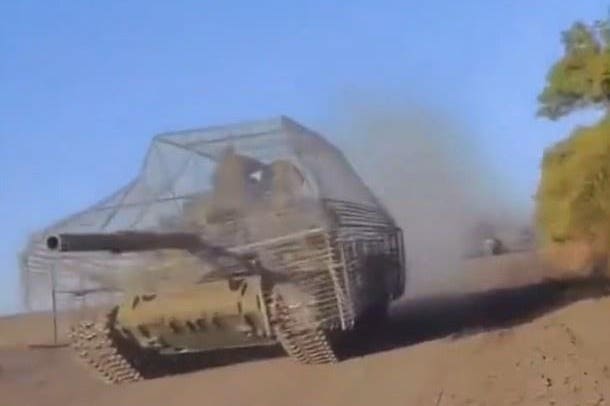Not content to weld ridiculously tall cage-style anti-drone armor on the tops of their old T-62 tanks, Russian forces in Ukraine now completely are surrounding some of the aged tanks in the bird-cage-style armor.
The result, on display in a video that circulated online on Sunday, is an extremely unwieldy combat vehicle. One that trades its mobility for protection. But only protection against certain kinds of attacks.
In wrapping a T-62 from tread to turret in slat armor, the Russians are assuming—probably accurately—that explosives-laden drones are among the biggest threats to the 1960s-vintage tanks.
The Kremlin reactivated hundreds of old T-62s starting in the summer of 2022, as losses of more modern tanks—150 or more a month—began far outstripping construction of new tanks.
Inexpensive drones, each hauling a couple of pounds of explosives, indeed are serious threats to tanks and other combat vehicles on both sides of Russia’s 21-month wider war on Ukraine. $5,000, radio-controlled FPV drones have knocked out hundreds of vehicles on both sides.
But most FPV drones range just a few miles. That makes them top killers of tanks in assault echelons fighting at the line of contact between Russian and Ukrainian troops. FPV drones were partially responsible for some of the highest-profile attacks on Ukraine’s Leopard 2 and Challenger 2 tanks.
The problem, for front-line tanks, is that they can’t afford to trade away too much mobility—not even for protection from drones. These tanks have to move fast, in and out of cover, in order to support combined-arms assaults on enemy positions.
Cage armor that doubles a tank’s size obviously impedes the tank’s concealability. Good luck hiding a tank that can’t squeeze itself into a typical Ukrainian treeline. It’s for that reason that, when a front-line tank wears anti-drone cage armor, it typically wears it judiciously.
The 40-ton, four-person T-62 isn’t an assault tank, however. Its 115-millimeter gun lacks the power of the 125-millimeter gun that arms newer Russian tanks. The T-62 likewise is poorly protected relative to modern tanks, with armor that’s just 240 millimeters thick at its thickest. That’s a quarter as much protection as, say, a Ukrainian Leopard 2A6 enjoys.
No, the Russians deploy the T-62 not as a tank, but as artillery. By superelevating its gun, a T-62 should be able to engage a target as far as five miles away, albeit inaccurately. T-62s and older T-54/55s doubling as howitzers lately have helped the Russians quickly to make good escalating losses of actual howitzers.
Five miles puts the T-62 at the outside edge of a typical FPV drone’s effective range. But close enough that at least one Russian regiment is worried about these drones above all else. A purpose-built howitzer might shoot far enough—10, 15 or even 20 miles—that drones are a diminishing threat.
Not so the T-62-turned-howitzer. It can’t outrange all FPV drones, so its crew better had protect itself some other way. Even if this protection makes the tank extra bulky.
Perhaps a top-to-bottom bird cage of slat armor might help.
Read the full article here





